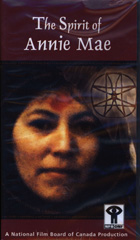
The Spirit of Annie Mae 2002
Distributed by National Film Board of Canada, 1123 Broadway, Suite 307, New York, NY 10010; 800-542-2164
Produced by Kent Martin
Directed by Catherine Anne Martin
VHS, color, 73 min.
College - Adult
Canadian Studies, Native American Studies, Women's Studies
Date Entered: 11/09/2018
Reviewed by Barbara A. Butler, Director of Library Service, Tolland Public Library, Tolland, CT, J. Eugene Smith Library, Eastern Connecticut State University, Willimantic, ConnecticutHow does a Mi’kmaw native person born in Nova Scotia end up murdered on the Pine Ridge Reservation in South Dakota? This excellent documentary recounts the events that led to the execution of activist Annie Mae Pictou Aquash. Unfortunately, her murder has never been solved. Based on interviews with Annie Mae’s daughters, first person accounts of her friends and coworkers, archival footage, and letters and audio interviews with Annie Mae, the documentary pieces together the chain of events that led to her death in 1975. Annie Mae was born in 1945, and like many native people left Nova Scotia at an early age to find work in Maine and later in Boston.
Annie Mae, pregnant with her second child, left Boston for Indian Island, New Brunswick to stay with her mother. It was on Indian Island that she met Chief Peter Barlow who introduced her to native history and ignited a passion in her to learn more. As a result, she became active in the militant American Indian Movement (AIM.) Annie Mae participated in many of the demonstrations and protests of AIM - Mount Rushmore, the 1971 Thanksgiving Day, “National Day of Mourning” in Plymouth, Massachusetts, the Trail of Broken Treaties in Washington, D.C., and the Wounded Knee Occupation. Annie Mae’s story is intricately tied to the tumultuous events of the late 1960s and early 1970s - the Vietnam War, the Civil Rights Movements, and the Nixon debacle. In an effort to stem the tide of civil unrest, the government’s counter intelligence program targeted anyone who dissented. Annie Mae’s activities brought her to the attention of federal law enforcement agencies - AIM was considered a threat to national security. AIM was not without problems from within - paranoia and power struggles ripped AIM apart as FBI informants infiltrated the organization. Annie Mae was suspected of being an FBI informant and suspicions persist that it was AIM who kidnapped, interrogated, and executed her.
Catherine Anne Martin not only directed this outstanding film but narrated it as well. The black and white archival footage presents a stark contrast to the color cinematography of present-day interviews and the strikingly beautiful images of the Black Hills of South Dakota. The film not only details the story of the Native Peoples Movement in the late 1960s and early 1970s, but also places the events in their historical context by explaining the significance of Mount Rushmore, the Fort Laramie Treaty, and Little Big Horn. In addition, The Spirit of Annie Mae explains why a native person from Nova Scotia was in South Dakota. One of Annie Mae’s friends put it succinctly, “Indian people are all one country from Canada clear down to South America.” This documentary is highly recommended for all academic collections.